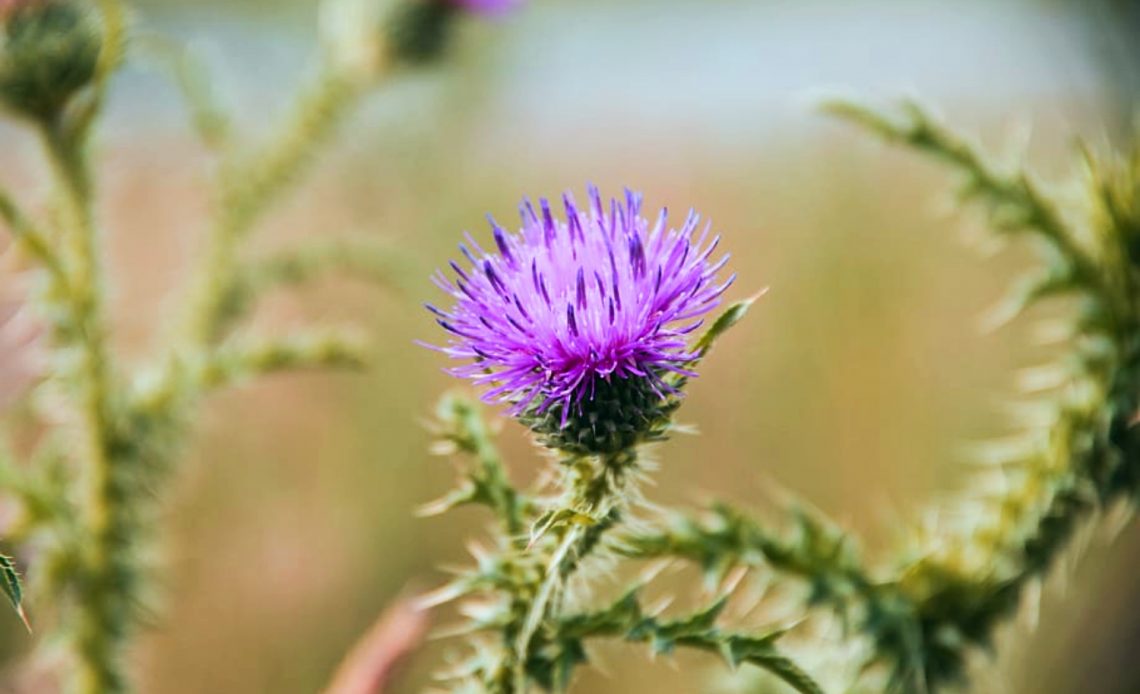

We’re here to help! Wild Yards is a completely free website that is 100% dedicated to helping you create a wildlife-friendly, sustainable yard. Read more
WildYards is reader-supported. When you buy a product through a link on our site, we may earn a comission. Every product is independently selected by our (obsessive) editors and our reviews are unbiased and objective. Read more about our mission or our privacy policy.
You’ve tested your soil, applied the correct fertilizers, and watered religiously. Now, there’s only one thing standing between you and the lush, velvety-soft lawn of your dreams.
Weeds.
If you woke up one morning to the sight of purple flowering weeds sticking out like a sore thumb amongst your well-manicured lawn, you may wonder just what they are, and if they’re a threat to you, your children, and your pets.
Knowing which weeds with purple flowers are growing in your yard is important for you, and for your family’s safety.
Being able to identify these weeds enables you to remove them effectively. It can also tell you a little bit about your lawn’s growing conditions.
Creeping Charlie, henbit, purple deadnettle, and selfheal are among the most common weeds with purple flowers. Prickly thistles are also a frequent sight, though nowhere near as dangerous as black nightshade.
Wild Violet
| Scientific name | Viola sororia |
| Native range | North America |
| Growth rate | Slow to moderate |
| Maximum size | 4” to 8” tall by 6” to 12” wide |
| Growing zones | 3 through 8 |
| Light requirements | Full to partial shade |
| Soil requirements | Sandy to loamy, moist but well-draining |
| Moisture needs | Moderate |
| Toxicity | Non-toxic |
Of all of the weeds with purple flowers that could sprout up on your lawn, wild violets have got to be some of the most benign.
First of all, not only are wild violets non-toxic, their flowers are edible, and can be candied and used to decorate cakes, cookies, and dessert breads.
Second, these flowers provide your local bees and butterflies with an early source of pollen.
Like dandelions, wild violets help insects refuel after the cold winter months before other flowers begin blooming in full swing.
While some may consider wild violets to be a weed, many gardeners purchase wild violets from nurseries to add to their flower beds.
So if you’ve got wild violets coming up in your yard on their own, consider yourself lucky!
While you can always remove wild violets, either with a trowel or weed torch, why not move a few to your flower beds to show your local pollinators some love?
Their slow to moderate growth rate means wild violets are easy to control. So even if new plants sprout up where the old ones were, you can easily dig them up.
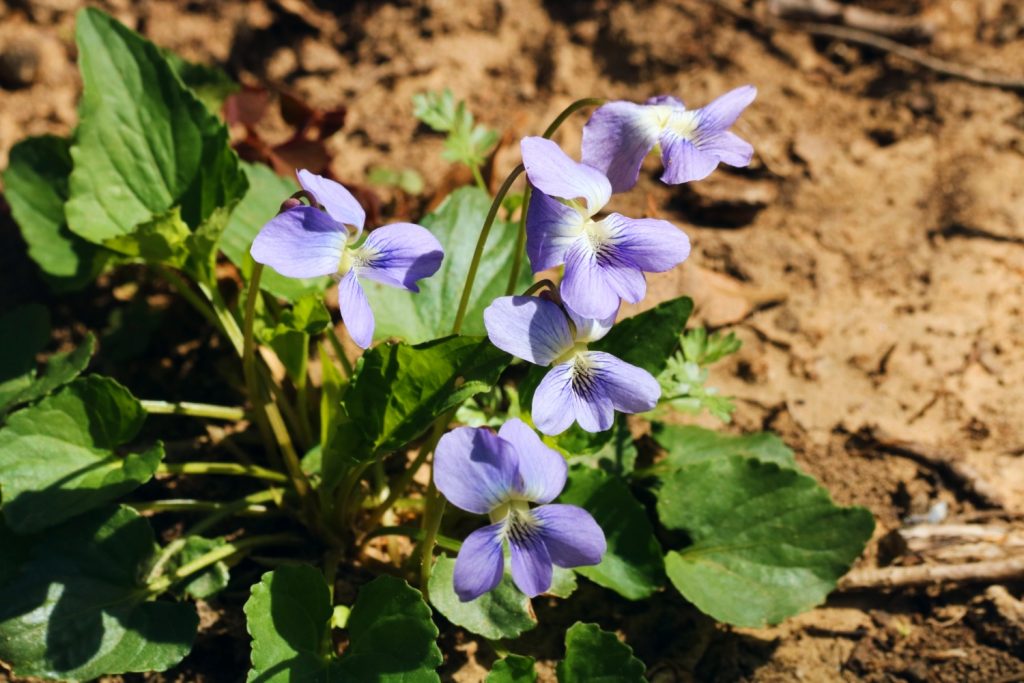
Creeping Charlie
| Scientific name | Glechoma hederacea |
| Native range | Asia, Europe |
| Growth rate | Fast |
| Maximum size | 6” to 8” tall by 24” to 36” wide |
| Growing zones | 4 through 9 |
| Light requirements | Partial sun |
| Soil requirements | Sandy to loamy, well-draining |
| Moisture needs | Moderate |
| Toxicity | Non-toxic |
Creeping Charlie, also known as ground ivy, is a member of the mint family, Lamiaceae, and produces small bluish-purple flowers in spring, which are especially popular with honeybees.
Often found growing in ditches, pastures, and parks, this perennial plant actually makes a nice ground cover for flower beds since it grows so quickly.
Although considered by many to be a weed, Creeping Charlie acts as a living mulch, keeping the soil cool for the other plants in your landscaping, and protecting the soil from rapid moisture loss.
Creeping Charlie is easy to identify, especially if you’ve grown mint before.
This adorable plant’s rounded leaves and scalloped edges make it a perfect choice for cottage-inspired landscapes.
Creeping Charlie is prized for its medicinal purposes, and can be used to treat bloating, indigestion, gas, headaches, and sore throats.
As with wild violets, simply moving Creeping Charlie to a different location in your garden would be a great option that your local pollinators would benefit from.
But you can remove this plant with the help of a weed torch, instead, if you’d prefer.
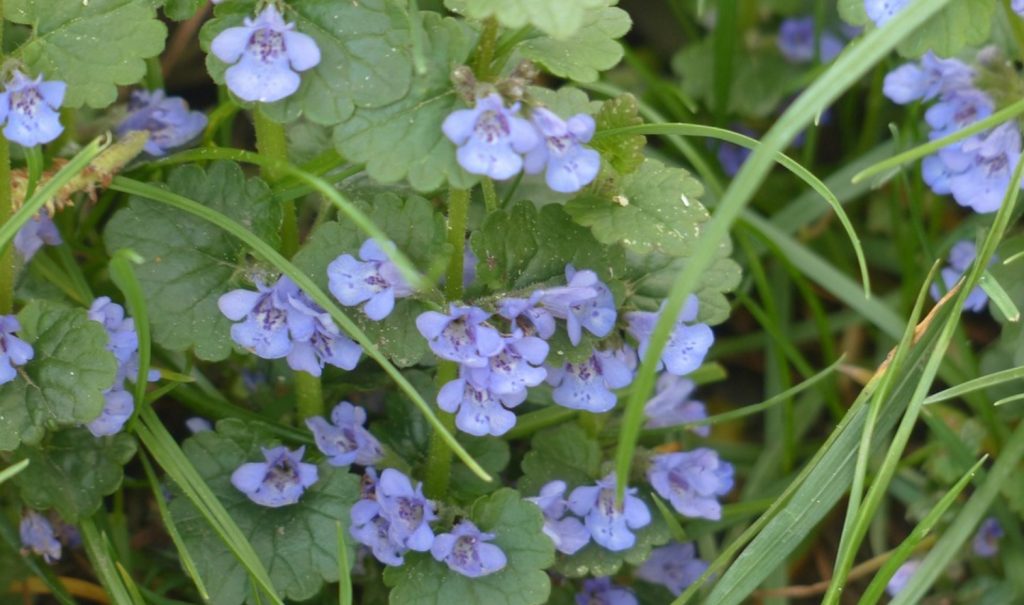
Henbit
| Scientific name | Lamium amplexicaule |
| Native range | Asia, Europe |
| Growth rate | Fast |
| Maximum size | 4” to 12” tall by 12” to 24” wide |
| Growing zones | 3 through 8 |
| Light requirements | Full to partial shade |
| Soil requirements | Loamy, moist |
| Moisture needs | Moderate |
| Toxicity | Non-toxic |
Henbit is another member of the Mint family.
Like Creeping Charlie, henbit has rounded, scalloped leaves, and delicate purple flowers.
Henbit is a cool-season weed, and an annual, which makes it fairly easy to keep under control.
If you spot henbit growing in your lawn, simply keep it mowed down to prevent it from flowering and going to seed. The plants will be dead and gone by next year.
Henbit can often be found growing in lawns and gardens. It’s adaptable to a wide variety of soil types, and can even be seen growing in rocky soils in between large cracks in parking lots.
This plant’s hardy nature makes it a great choice of ground cover for low-maintenance pollinator gardens.
Henbit is edible and quite tasty. The flowers and foliage make a delicious tea. But the plant can also be used to jazz up soups, salads, and sauteed side dishes.
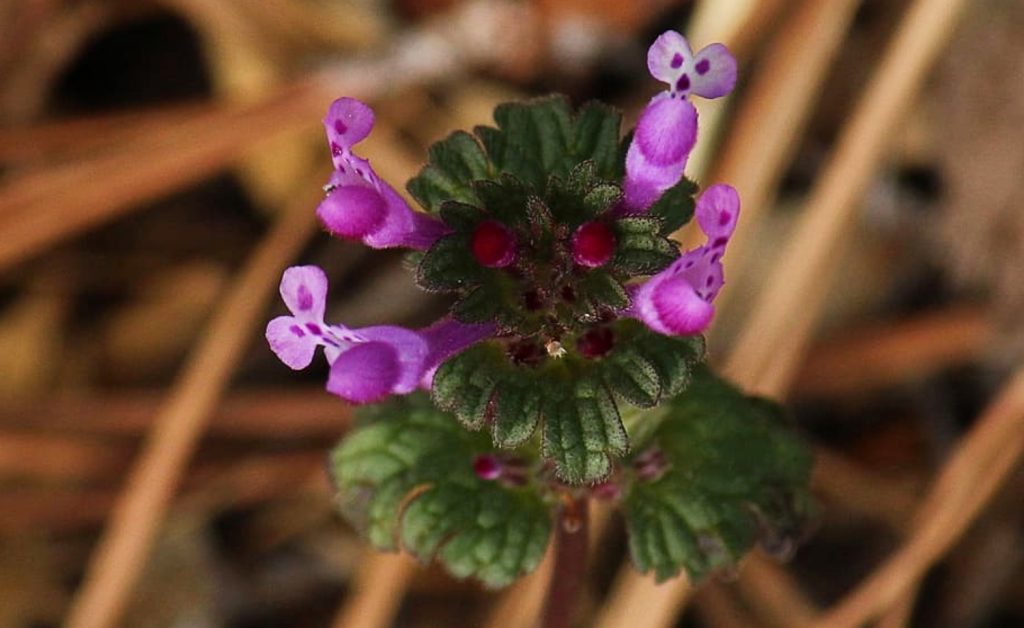
Dove’s-Foot Crane’s-Bill
| Scientific name | Geranium molle |
| Native range | North America, Asia, Europe |
| Growth rate | Moderate |
| Maximum size | 12” to 24” tall by 24” to 36” wide |
| Growing zones | 3 through 8 |
| Light requirements | Full to partial shade |
| Soil requirements | Sandy to loamy, well-draining |
| Moisture needs | Moderate |
| Toxicity | Non-toxic |
Sometimes mistaken for clover or dollar-weed, dove’s-foot crane’s-bill is a relative of the geranium and produces distinctive palmate leaves and tiny open-faced purple flowers.
Dove’s-foot crane’s-bill is actually quite pretty, although many homeowners consider it to be a pesky weed because it can be incredibly invasive.
One way to get rid of dove’s-foot crane’s-bill is to plant clover or creeping thyme nearby. These equally fast-growing ground covers can outcompete dove’s-foot crane’s-tail, eradicating it from your lawn.
Of course, if you’d rather not snuff out your turf with any type of ground cover, you’ll need to utilize other methods of weed removal to get rid of dove’s-foot crane’s-bill once and for all.
Due to their spreading nature, it’s best to spray dove’s-foot crane’s-bill with a broadleaf herbicide, like dicamba, to nip it in the bud.
Selfheal
| Scientific name | Prunella vulgaris |
| Native range | Asia, Europe |
| Growth rate | Moderate |
| Maximum size | 4” to 12” tall by 12” to 24” wide |
| Growing zones | 4 through 8 |
| Light requirements | Full to partial sunlight |
| Soil requirements | Sandy to loamy, well-draining |
| Moisture needs | Low |
| Toxicity | Non-toxic |
Selfheal, or healall, is a perennial plant, and yet another member of the mint family.
This flowering weed can grow quite tall and dense. This plant thrives in loose, loamy soil that can easily be kept moist. That said, it’s also somewhat drought-tolerant once established.
Selfheal produces square stems that are thick and sturdy. In the spring and summer months, this plant produces beautiful purple flowers that look a lot like lavender.
If you’re a fan of wildflowers and native plants, consider moving selfheal to your flower beds.
This plant can help you attract no end of bees, butterflies, and other beneficial insects.
But if you’d rather just get rid of it, then simply take a weed torch to them, uproot them, or apply a broadleaf herbicide to them.
Like some of the other weeds mentioned here, selfheal is prized for its healing properties.
This weed has potent anti-inflammatory and antioxidant properties that make it well-suited to treating minor ailments, like sore throats.
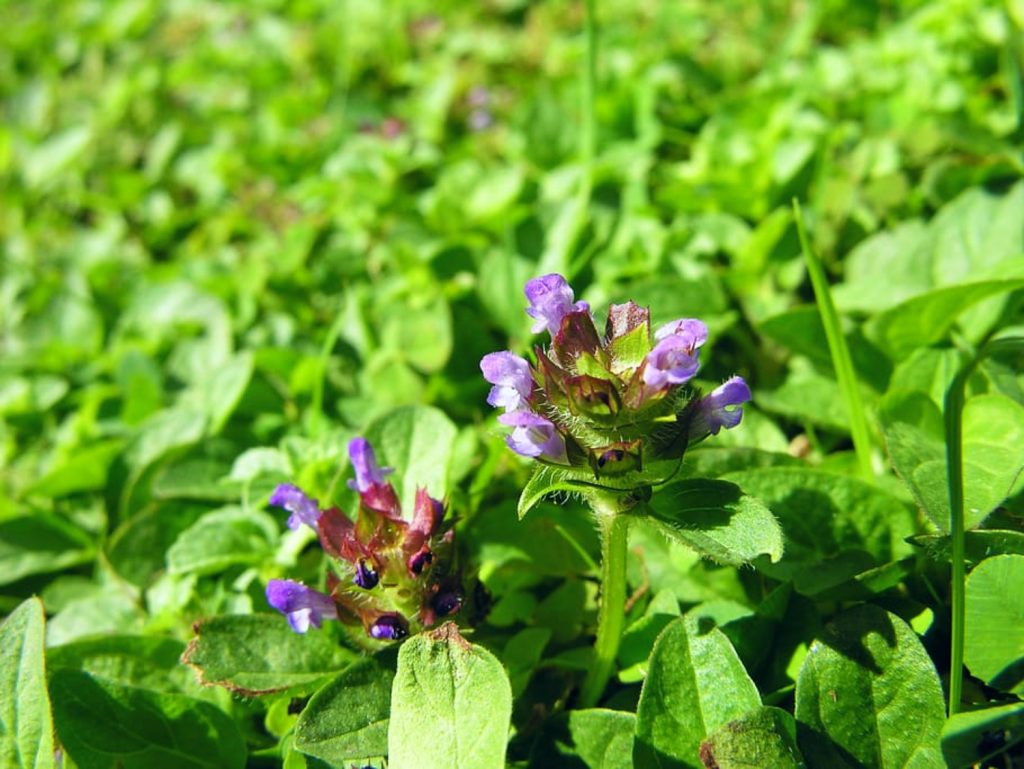
Ironweed
| Scientific name | Vernonia fasciculata |
| Native range | North America |
| Growth rate | Moderate to fast |
| Maximum size | 3’ to 6’ tall by 1’ to 3’ wide |
| Growing zones | 3 through 7 |
| Light requirements | Full to partial sunlight |
| Soil requirements | Sandy, loamy, clay-rich, well-draining |
| Moisture needs | Moderate |
| Toxicity | Non-toxic |
Ironweed looks a lot like mistflower at first glance. But this weed with purple flowers can grow much taller. In ideal conditions, this plant can grow up to 6 feet!
Ironweed may be an unsightly blemish on your otherwise perfect lawn. But the good news is, it’s non-toxic.
This plant does not pose a threat to children or pets.
Ironweed can often be found growing in ditches and other areas that have well-draining soil, and that flood during brief periods throughout the year.
Plants bloom in late summer, producing intricate purple flowers that pollinators enjoy browsing.
This plant is a perennial. Many gardeners favor it for its lovely flowers, and because it’s so easy to care for.
But if you want to get rid of ironweed, you can always uproot the plants with a hand trowel. For large areas, apply a broadleaf herbicide to get rid of this weed.
Forget-Me-Nots
| Scientific name | Myosotis sylvatica |
| Native range | Asia, Europe |
| Growth rate | Moderate |
| Maximum size | 6” to 18” tall by 12” to 18” wide |
| Growing zones | 3 through 8 |
| Light requirements | Full to partial sunlight |
| Soil requirements | Sandy to loamy, fertile, moist but well-draining |
| Moisture needs | Moderate |
| Toxicity | Non-toxic in small doses; mildly toxic if/when large quantities are ingested |
Many gardeners use forget-me-nots as a border for their flower beds. But they’re actually considered to be weeds.
The forget-me-not’s delicate blue-to-purple flowers have five oblong petals and delicate yellow centers. It’s not hard to see why so many gardeners love it.
Forget-me-nots, like wild violets, can be candied and used to decorate baked goods. Their adorable good looks make them well-suited to the task.
These tiny flowers have a sweet, floral taste that also works well when mixed with rose petals, lavender, and orange peel and steeped into a tea.
These plants are easy to care for, largely because they really don’t need to be cared for.
That said, they can become invasive if left to their own devices. If you want to keep your lawn’s forget-me-not population under control, you’ll need to take measures to rein it in.
Regular mowing will help control forget-me-nots, and a weed torch will work well for spot-treating.
If both of those measures fail, consider using a broadleaf pesticide, instead.
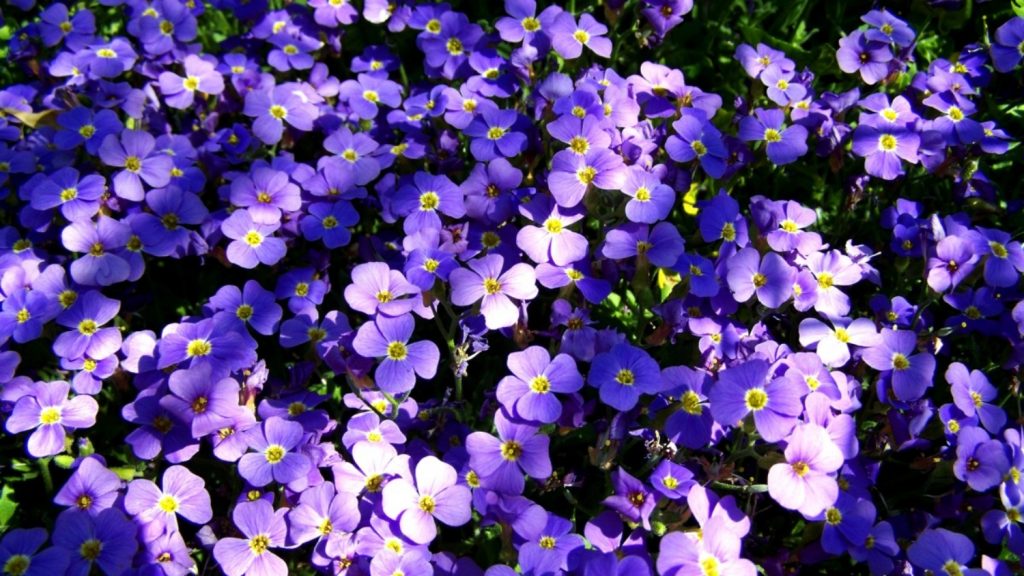
Purple Deadnettle
| Scientific name | Lamium purpureum |
| Native range | Asia, Europe |
| Growth rate | Fast |
| Maximum size | 6” to 12” tall by 12” to 18” wide |
| Growing zones | 4 through 8 |
| Light requirements | Full to partial sunlight |
| Soil requirements | Sandy to loamy, moist |
| Moisture needs | Moderate, somewhat drought-tolerant |
| Toxicity | Non-toxic |
So many weeds belong to the mint family! Purple deadnettle is another purple flowering weed and a close relative of mint.
These plants can be found taking over sunny areas, especially those with sandy, well-draining soils.
Purple deadnettle produces foliage with a crinkled appearance. Leaves are covered in fine hairs, and the plant’s flowers are tubular in shape.
This weed is also edible, most often used to garnish baked goods or added to spring salads.
Once again, a broadleaf pesticide can be used to keep this weed under control. Digging purple deadnettle up with a hand trowel may be effective, but usually only for small areas.
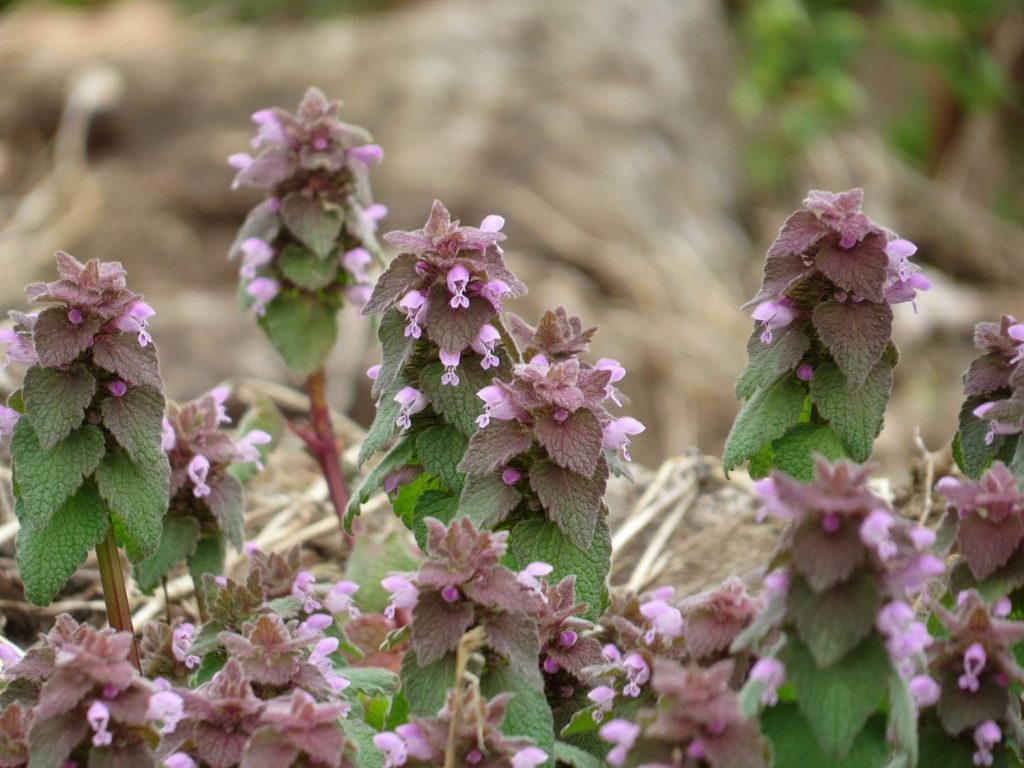
Bird Vetch
| Scientific name | Vicia cracca |
| Native range | Eurasia, Africa |
| Growth rate | Fast |
| Maximum size | 24” to 36” tall by 24” to 36” wide |
| Growing zones | 3 through 8 |
| Light requirements | Full to partial sunlight |
| Soil requirements | Sandy, loamy, clay, nutrient-poor; prefers well-draining |
| Moisture needs | Low |
| Toxicity | Non-toxic |
This trailing vine is a member of the Fabaceae family and a close relative of the pea.
This weed’s blue to purple tubular flowers are always popular with pollinators.
Many gardeners use this plant’s fast-growing and easy-going nature to their advantage by planting this vine along fencelines and up trellises.
While many homeowners consider bird vetch to be a weed, this perennial can actually be a good thing.
That’s because bird vetch, like other legumes, is a nitrogen fixer, turning nitrogen from the air and soil into a form that is more usable for surrounding plants.
If you have bird vetch growing in your yard, you can uproot it, spray it with an herbicide, or torch it.
But if you do, be sure to feed your lawn a high-nitrogen fertilizer to make sure it meets all of its nutrient requirements once the bird vetch is no longer around to convert nitrogen.
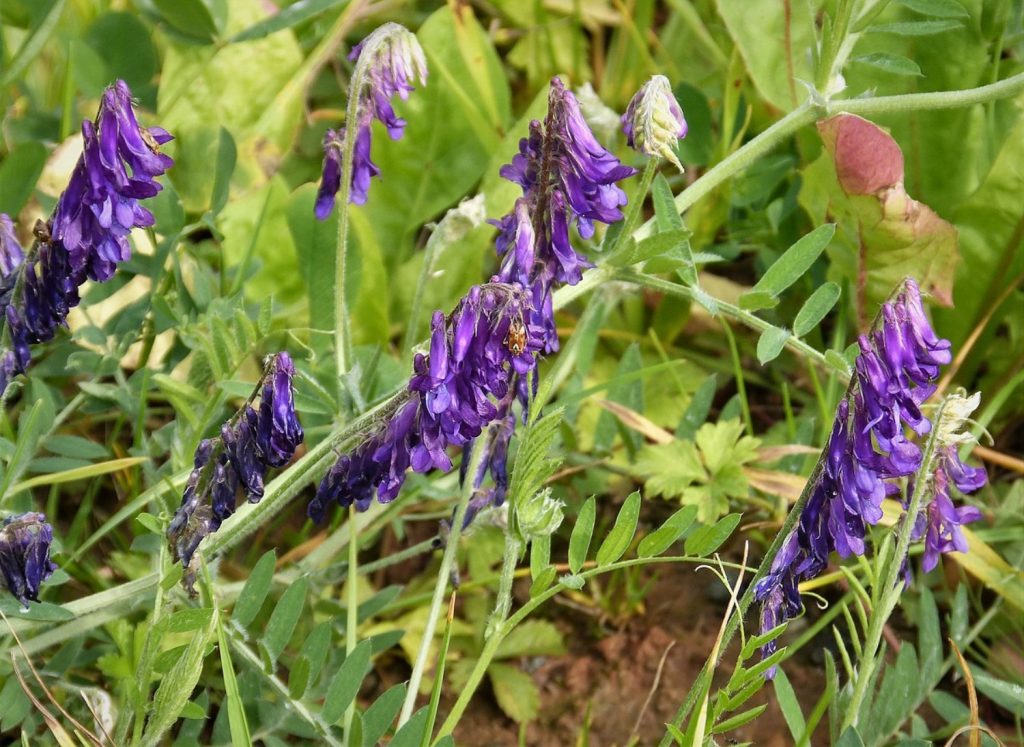
Black Nightshade
| Scientific name | Solanum dulcamara |
| Native range | Asia, Europe |
| Growth rate | Moderate to fast |
| Maximum size | 1’ to 3’ tall by 1’ to 2’ wide |
| Growing zones | 4 through 8 |
| Light requirements | Full to partial sunlight |
| Soil requirements | Sandy to loamy, moist but well-draining |
| Moisture needs | Low |
| Toxicity | Toxic berries |
As big fans of pollinators and native plants, we’re ready to defend just about every weed on this list. But not black nightshade.
If you have black nightshade on your lawn, you need to get rid of it ASAP.
Also known as bittersweet nightshade, ingesting any part of black nightshade, from the leaves to the tomato-like fruits, can prove toxic to both humans and animals. So the sooner you get rid of it, the better.
While this plant’s purple star-shaped flowers with golden yellow centers are lovely, they come with potentially deadly consequences.
A member of the Solanaceae family, black nightshade can be eradicated with the help of a weed torch. This plant can be quite invasive, so for large areas, apply a broadleaf herbicide.
Black nightshade can be irritating to the skin and sinuses, so wear goggles, gloves, long sleeves, and pants when handling it.
Purple Clover
| Scientific name | Dalea purpurea |
| Native range | North America |
| Growth rate | Moderate |
| Maximum size | 12” to 24” tall by 24” to 36” wide |
| Growing zones | 4 through 9 |
| Light requirements | Full to partial sunlight |
| Soil requirements | Sandy to loamy, well-draining |
| Moisture needs | Low, drought-tolerant |
| Toxicity | Non-toxic |
Purple clover is another nitrogen fixer, transforming your soil into a nutritional substrate for the plants in your lawn and garden.
Clover is a popular choice of plant for cottage-inspired landscapes. It’s easy to care for, and bees and butterflies never seem to tire of this weed’s gorgeous purple flowers.
Purple clover makes for a simple yet effective ground cover for flower beds and pollinator gardens.
The weed’s flowers draw the attention of beneficial insects, and the plant’s foliage acts as a living mulch to protect neighboring plants.
But, unfortunately, clover can be incredibly invasive. So much so that it can threaten the grass growing on your lawn.
To keep purple clover under control, opt for a pre-emergent herbicide, like napropamide, that neutralizes the plant’s seeds before they get a chance to sprout.
If clover has already come up in full force and is threatening your expensive turf, try a post-emergy herbicide, like clopyralid, instead.
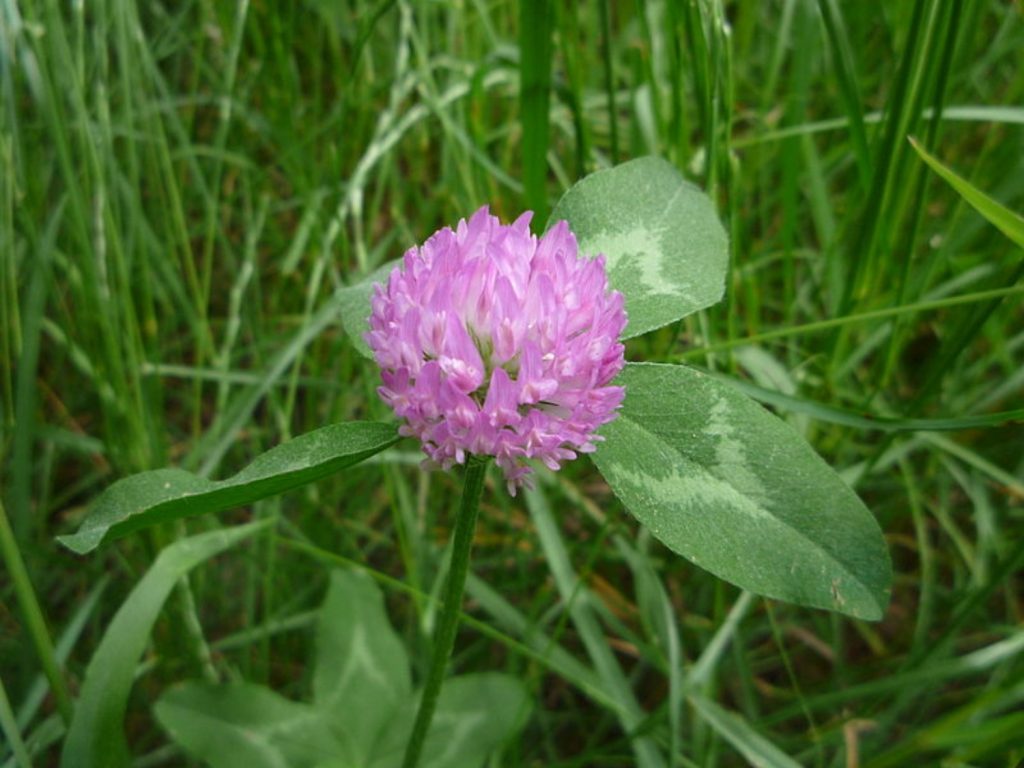
Common Burdock
| Scientific name | Arctium minus |
| Native range | Africa, Eurasia |
| Growth rate | Fast |
| Maximum size | 2’ to 6’ tall by 1’ to 3’ wide |
| Growing zones | 3 through 9 |
| Light requirements | Full to partial shade |
| Soil requirements | Sandy to loamy, nutrient-poor |
| Moisture needs | Low |
| Toxicity | Non-toxic |
Landscapers love plants with heart-shaped leaves. After all, what could be more romantic?
But for many gardeners, the common burdock’s heart-shaped leaves aren’t enough to make it worth sparing.
Common burdock looks a lot like a thistle, but it’s not quite the same.
Common burdock is a biennial plant that blooms from late summer to fall. The flowers look a lot like a thistle, with purple florets appearing at the ends of spiked balls.
Near the end of the season, the flower’s give way to burrs, which can easily get trapped in animal fur and clothing, allowing the plant to propagate elsewhere.
This type of weed can be difficult to control due to the fact that its seeds can be spread for miles.
Fortunately, because they’re so large, they’re pretty easy to spot. So you can take measures to control the plant’s growth before it gets out of hand.
A weed torch is the best way to tackle a common burdock problem. But broadleaf and pre-emergent pesticides are helpful as well.
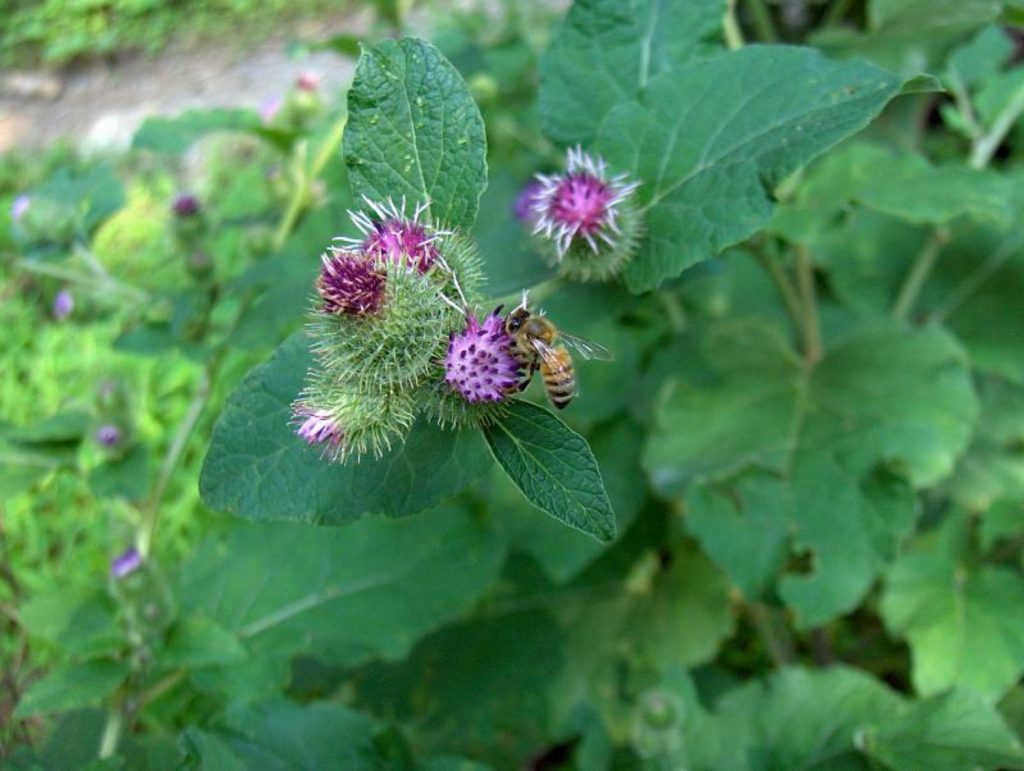
Thistles
Thistles are another type of weed commonly found in lawns and gardens. There are three main types of thistles, but how can you tell which one is which? Let’s find out!
Common Thistle
| Scientific name | Cirsium vulgare |
| Native range | Asia, Europe, Northwest Africa |
| Growth rate | Moderate to fast |
| Maximum size | 2’ to 4’ tall by 1’ to 3’ wide |
| Growing zones | 5 through 9 |
| Light requirements | Full to partial sunlight |
| Soil requirements | Sandy to loamy, well-draining |
| Moisture needs | Low |
| Toxicity | Non-toxic |
Common thistles are usually found in pastures, fields, and other open, grassy spaces.
These thistles thrive in many different types of soil, as long as they drain well. Common thistles can tolerate extreme heat and can thrive in full sunlight.
Flower heads range from deep pink to purple, but can also appear white or yellow. Common thistles are considered to be a major problem by many homeowners due to the fact that they’re covered in spines.
The sharp, stiff, unyielding foliage can be painful when touched. They can make walking through your lawn in shorts and flip-flops a nightmare.
That said, common thistles are popular with pollinators, particularly bumblebees and wasps.
Use pre-emergent herbicides to prevent common thistles from overtaking your turf, and spot-treat affected areas with a weed torch.
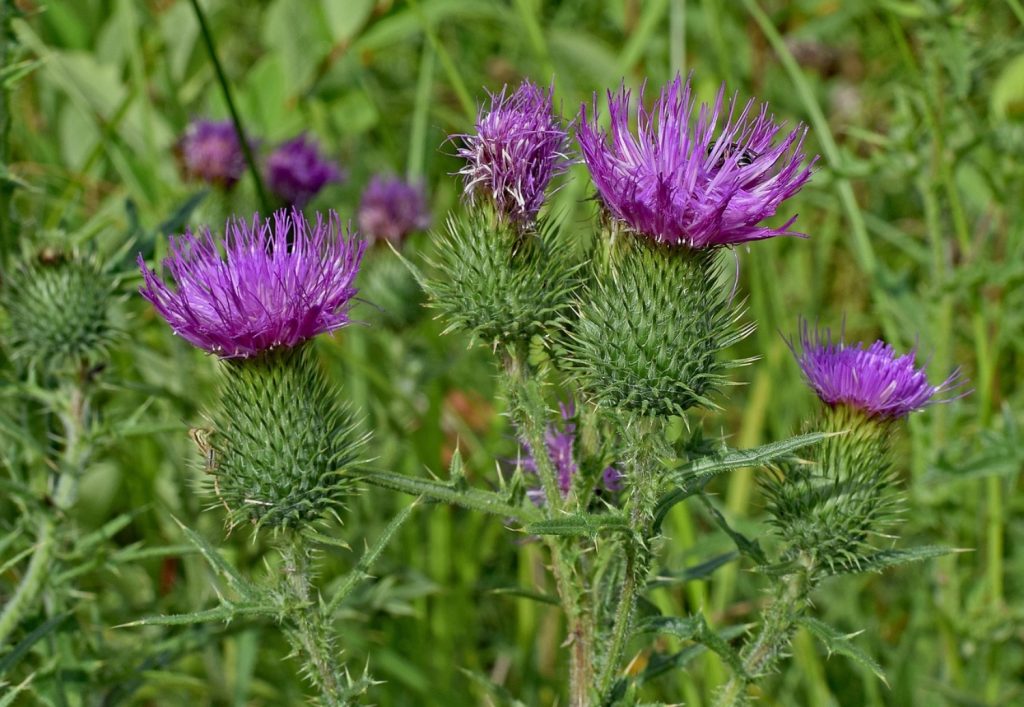
Musk Thistle
| Scientific name | Carduus nutans |
| Native range | Asia, Europe |
| Growth rate | Fast |
| Maximum size | 1’ to 6’ tall by 2’ to 3’ wide |
| Growing zones | 3 through 8 |
| Light requirements | Full to partial sunlight |
| Soil requirements | Sandy, loamy, clay, moist |
| Moisture needs | Low to moderate, somewhat drought-tolerant |
| Toxicity | Non-toxic |
Also known as nodding thistle, musk thistle is bigger and stouter than common thistle. Its flower heads are also rounder and flatter by comparison.
This biennial can be distinguished from other thistles easily, as its flower heads tend to nod.
Like other thistles, musk thistle can be found growing in open, grassy areas, in livestock pastures, abandoned fields, and along roadways.
The flowers are frequently visited by pollinators, particularly bees and wasps.
Unfortunately, the spines of this plant are quite painful to the touch, which is why so many homeowners are eager to rid their lawns of this pesky weed.
Aminopyralid-based pesticides work well for this weed with purple flowers, as this type of pesticide has low toxicity to grasses.
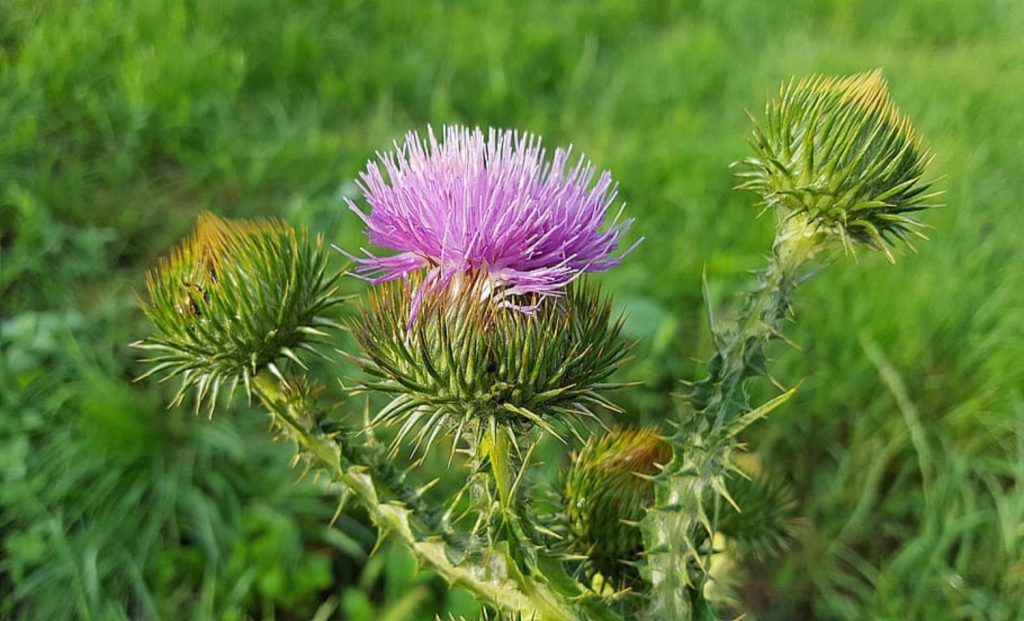
Creeping Thistle
| Scientific name | Cirsium arvense |
| Native range | Eurasia |
| Growth rate | Fast |
| Maximum size | 4’ to 6’ tall by 1’ to 3’ wide |
| Growing zones | 3 through 9 |
| Light requirements | Full to partial sunlight |
| Soil requirements | Sandy to loamy, moist but well-draining |
| Moisture needs | Low |
| Toxicity | Non-toxic |
Unlike common thistles and musk thistles, which produce one large flower at the end of a single sturdy stalk, creeping thistle is capable of producing multiple flower heads on multiple stems.
Creeping thistle’s pink to purple flowers are quite showy. For some people, that more than makes up for the plant’s prickly foliage. But for others? Not so much.
Creeping thistle can be a real pain. And because it spreads via rhizomes, it can be particularly difficult to control.
New shoots can form from the main plant’s root system, which means creeping thistle can take over your lawn in a season if you don’t act fast.
Use pre-emergent and post-emergent herbicides to keep creeping thistle under control. Or consider transplanting the plants to grow along your property line to keep trespassers out!
How can you prevent weeds from spreading on your lawn?
You know what they say: An ounce of prevention is worth a pound of cure.
If your lawn is your pride and joy, and you’d like to keep it that way, then you’ll need to take a proactive approach to prevent your yard from being taken over by weeds.
Here are a few things you can do to keep stickers, burrs, and weeds with purple flowers at bay.
Mow your lawn every 7 to 10 days
During the active growing season, mowing your lawn every week or week and a half is an easy way to keep the weeds in check.
Mowing plants during their growth period prevents them from being able to flower and go to seed and forces them to focus on producing new foliage. This limits their spread and, eventually, the plant dies out.
Keep your mower blades on a medium-low setting. Ideally, you want to remove about a third of the grass at one time, no more and no less.
This keeps your grass at the proper height so it can outcompete surrounding weeds.
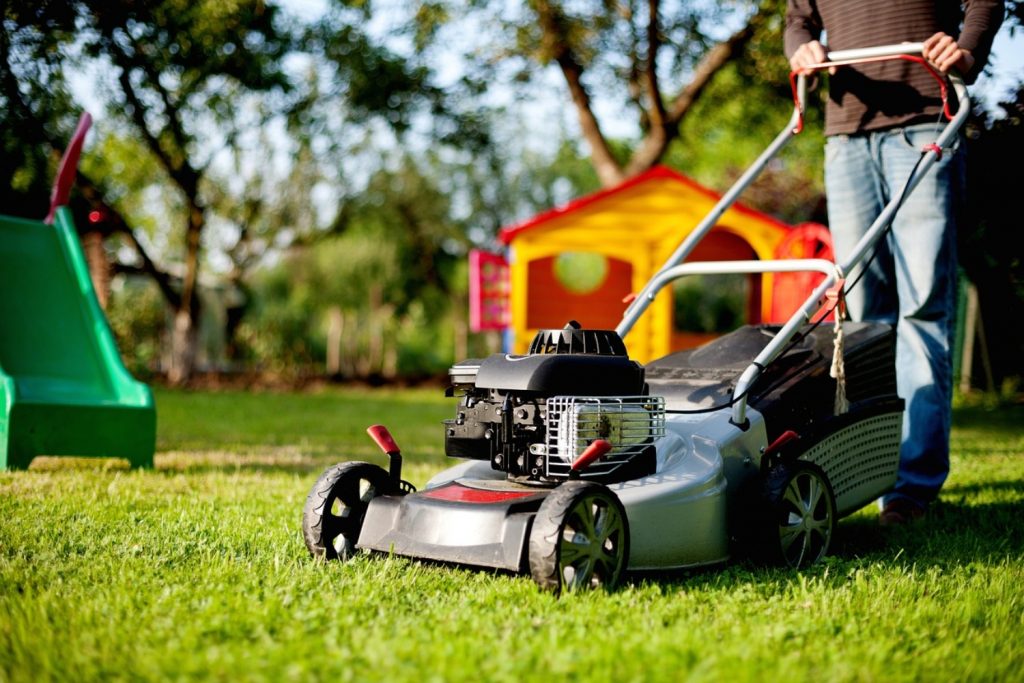
Water your lawn regularly
Many weeds with purple flowers have low water requirements. These plants are tough to kill and can thrive in bone-dry soils for long periods of time without a drop of water.
Grass, by comparison, isn’t nearly as hardy.
If you want your turf to fill in before weeds get a chance to spread, you’ll need to make sure you keep your lawn well-watered.
For best results, water once or twice a week, and avoid overwatering, which may lead to root rot.
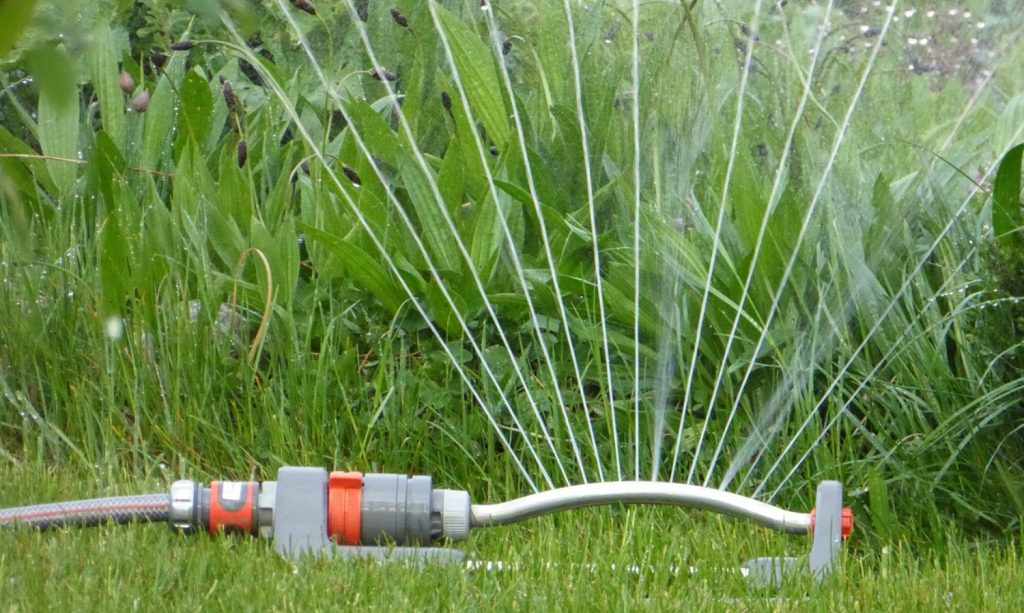
Overseed bare spots
It’s not unusual for any lawn to have a few brown patches.
Be sure to amend these areas with a bit of compost and over-seed them to compensate for the lack of growth.
Taking a few extra measures to support healthy grass growth in these areas will help keep weeds at bay.
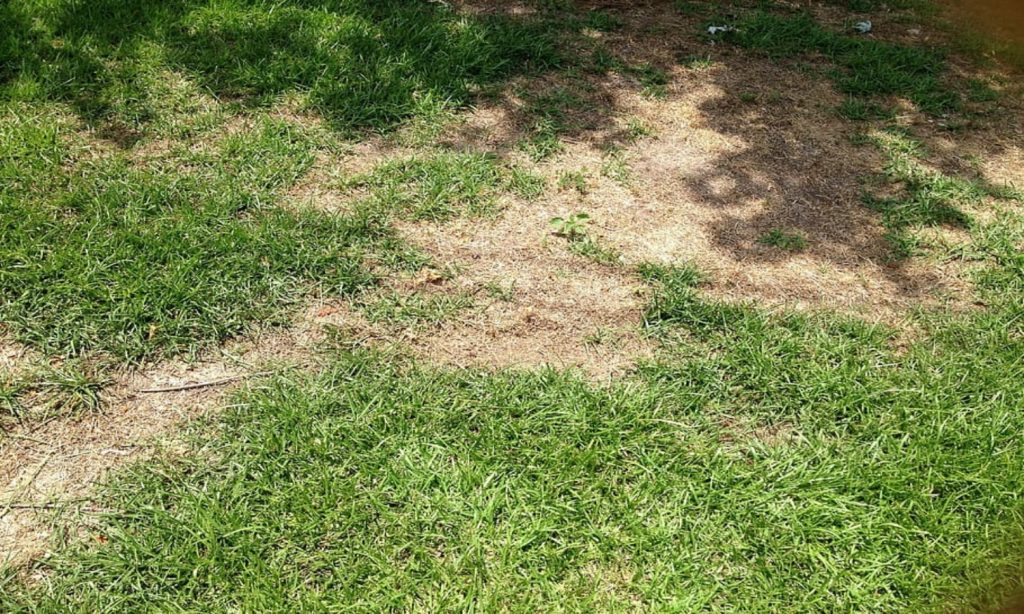
Improve soil health
Speaking of compost, let’s talk fertilizers.
Most homeowners apply balanced NPK fertilizers, like triple 16, or high-nitrogen fertilizers, like 30-0-10, to keep their grass nice and green.
And, to be sure, these fertilizers can help keep your plants healthy. But that’s just the problem. They support plant health and not soil health.
Organic fertilizers, like kelp meal, wood ash, and manure are much better for your lawn because they don’t just feed the plants, they feed the healthy bacteria in the soil.
Supporting the microbes in the soil keeps your grass healthy, making it easier for it to ward off pests and diseases.
It also ensures your grass gets all of the nutrients it needs to form a dense carpet over your lawn, which snuffs out weeds with purple flowers before they even get a chance to sprout.
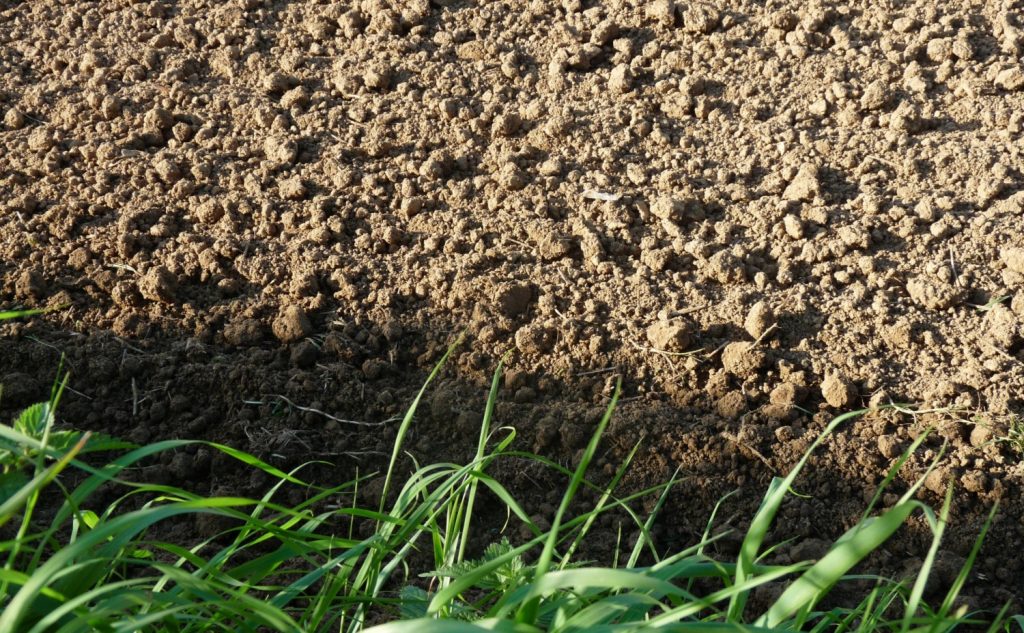
Remove weeds as you see them
If you spy a few weeds sprouting up here and there throughout the course of the growing season, don’t just stand there — grab a hand trowel and get to work!
Removing weeds as you find them may require a more proactive approach on your part. But it’s way easier than having to remove a whole bunch of weeds at once.
Doing a little bit of weeding every few days will help you stay on top of the weeds before they get out of hand.
Be careful when removing weeds that have gone to seed
It’s best to remove weeds before they’ve flowered, if possible.
Once a weed has gone to seed, then you run the risk of dispersing the seeds when you remove them.
Consider placing a bag over the weeds before removing them to help catch the seeds. This way, you won’t be creating more problems for yourself later on.
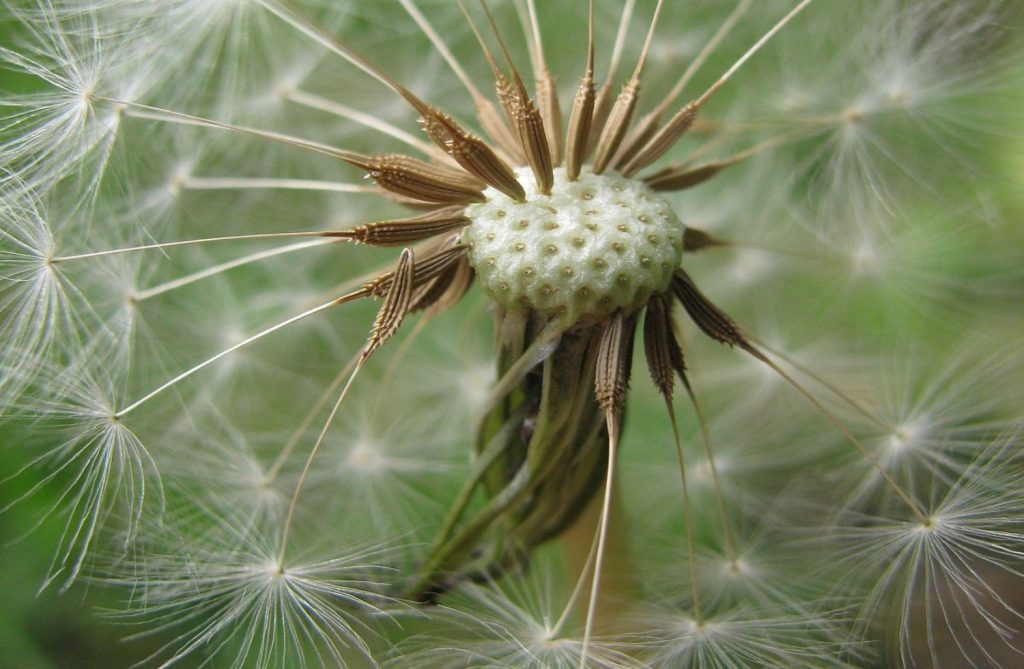
Use pre-emergent pesticides
Of course, you can’t prevent every seed from spilling. So make good use of a pre-emergent pesticide to keep the weed population to a minimum.
Pre-emergent pesticides prevent seeds from sprouting, so they never turn into a problem.
Just be sure to read the manufacturer’s instructions before applying a pre-emergent pesticide to avoid damaging the plants in your landscaping.
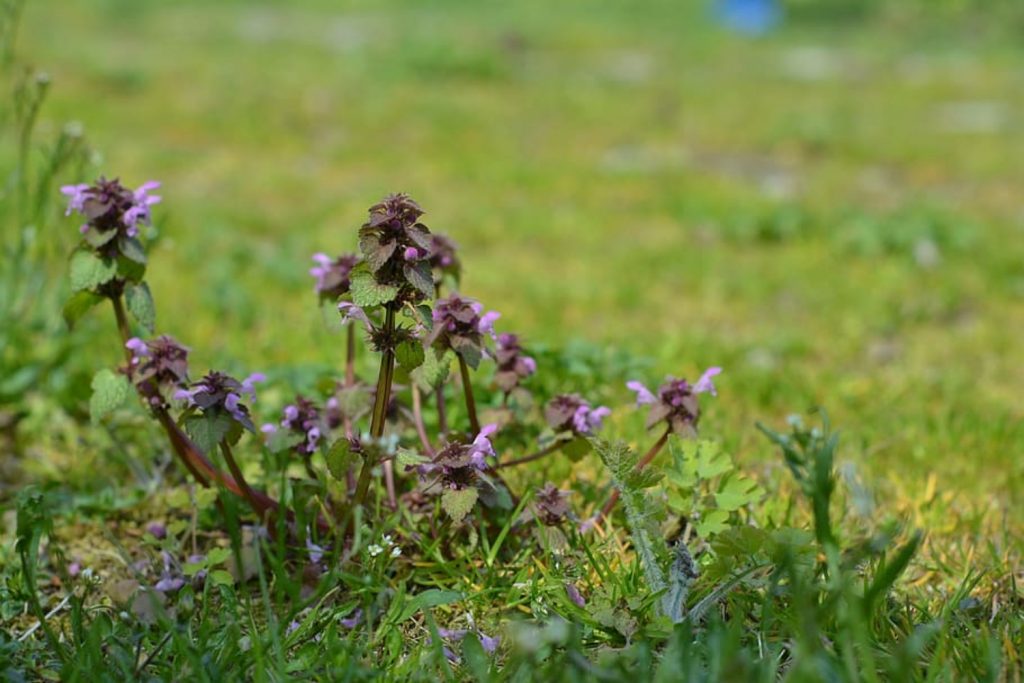
Consider re-wilding your lawn
Interested in learning more about green turf alternatives? Place your lawn in Mother Nature’s hands by re-wilding your lawn.
Let’s face it, fighting weeds is for the birds. You want less work, not more. If letting your lawn grow wild is easier than endless soil tests, fertilizer applications, mowing, and weed-eating, what’ve you got to lose?
We say let those weeds with purple flowers run riot (the non-toxic ones, that is).
These plants may be “invasive”, but they’re also effortless to maintain. And because so many of them are native, they’re uniquely suited to your ecoregion’s growing conditions.
Allowing native plants to grow unabated supports pollinators, which, in turn, supports birds, squirrels, and deer, and the ecosystem as a whole. And that sounds pretty good to us!
Coexisting with weeds with purple flowers
Okay, so maybe a wild lawn isn’t for everybody. But adding a few of these weeds with purple flowers to your landscaping is a great compromise.
Transplanting wild violets, forget-me-nots, and selfheal keeps these weeds out of the lawn you’ve worked so hard to maintain, while still leaving them available to hungry pollinators.
With a little effort, you can keep your lawn in pristine condition and support beneficial insects, too.
